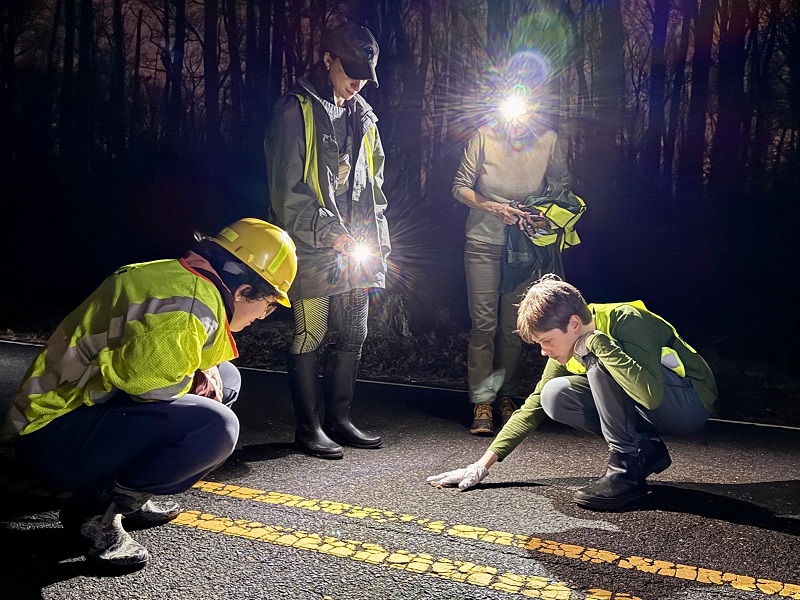Princeton Salamander Crossing Brigade Helps Amphibians Return Safely to Breeding Pools
MAKING IT SAFE: Volunteers with the Princeton Salamander Crossing Brigade were on hand recently to help local amphibians cross Herrontown Road without getting squished by cars during their annual migration to breed. Similar efforts take place each year across the globe.
By Anne Levin
On a warm, rainy night a few weeks ago, a group of dedicated volunteers gathered on Herrontown Road to help some tiny residents cross from one side of the road to the other.
Made up of Princeton High School students, Princeton University professors, local experts, and other citizens concerned about safeguarding the all-important amphibian population, the Princeton Salamander Crossing Brigade was on hand to help frogs and salamanders safely reach their breeding grounds along the Princeton Ridge. The migration takes place on a wet night in early spring, and it happens every year.
“They are keystone species,” said Inge Regan, a member of the Friends of Herrontown Woods (FOHW) who has organized the brigade for the past three years. “They feed on insects and worms, and are eaten by larger animals. Without that keystone species, there is a huge impact on the eco-system.”
Details about the migration are on the website princetonnaturenotes.org, which describes the amphibians as “charismatic and ecologically important creatures.” It continues, “After long winter dormancy, it’s these first warm, rainy nights that stir wood frogs, spring peepers, and spotted salamanders to action. Their goal is to reach the vernal pools that dot the woodlands of the ridge, where they will gather to mate and lay clusters of eggs before withdrawing back into the forest. Only one thing stands in their way.”
That is the crossing of Herrontown Road, which dates back to the early days of Princeton and “rides the top of the ridge, winding around the back side of Herrontown Woods,” the website continues. “Hundreds, perhaps thousands of amphibians, seeking the vernal pools in which they were born, unknowingly risk being crushed when they cross this strip of pavement. A spotted salamander can live more than 20 years, so that each loss has consequences for decades to come.”
This is the first year that the brigade has installed signs along the roadway. The bright yellow posts urge motorists to slow down and keep an eye out for the tiny creatures. Signs were made by sisters Charlotte and Sonja Michaluk and members of Boy Scout Troop 43.
By briefly closing the road, the brigade was able to record 119 amphibians making the trip, and no deaths. Whether the road can be closed in the future remains to be decided.
In some locations where amphibians are known to travel across roads, tunnels have been built to allow their passage. “But there can be potential problems, like dust from the traffic,” said Regan. “You have to maintain the tunnels. And will they definitely go under them?”
Members of the brigade, who wear headlamps and have special gear, are trained by the Sourland Conservancy. They learn how to “scoop and carry,” always in the direction the amphibians want to go. Any creature that gets crushed by a car is removed so it is not recounted and included in the final tally.
Some 29 or 30 people are part of the brigade. One of the advisors watches the weather to determine when the crossing night will likely take place.
“Once it comes, there is a mad rush,” said Regan. “We meet in a safe location where we gear up and get into teams. It depends on whether there are road closures or not. There is always someone gathering data, which gets submitted to the New Jersey Fish and Wildlife department through the Sourland Conservancy.”
At FOHW’s Earth Day celebration on April 12 in Herrontown Woods, there will be amphibian hikes and hands-on display tables near the Veblen House. The event takes place from 10 a.m. to 3 p.m.
“The salamander table will be huge. This is a way for people to learn more about what we’re doing,” said Regan, who is a physician. “Our botanists are the physicians of the earth. That’s where I need to learn more.”


